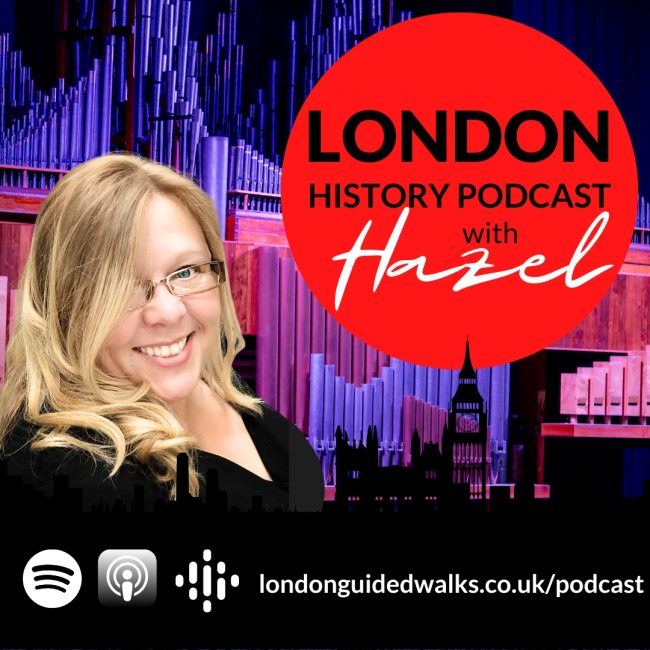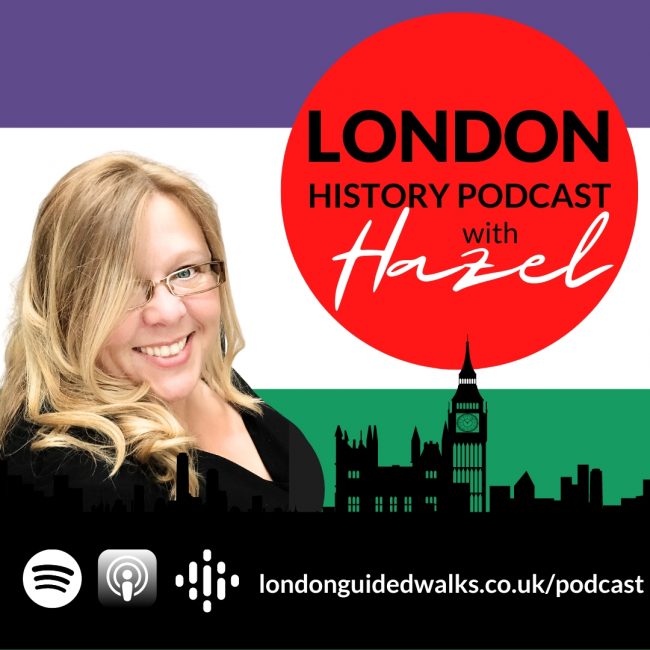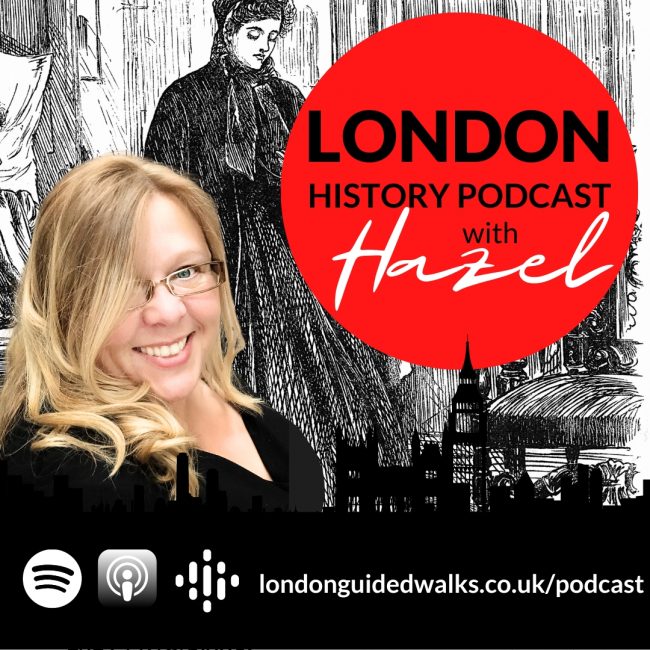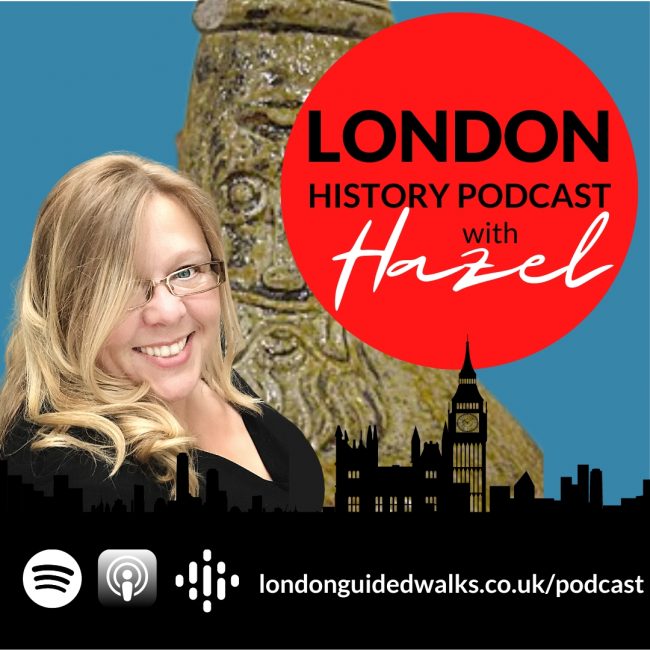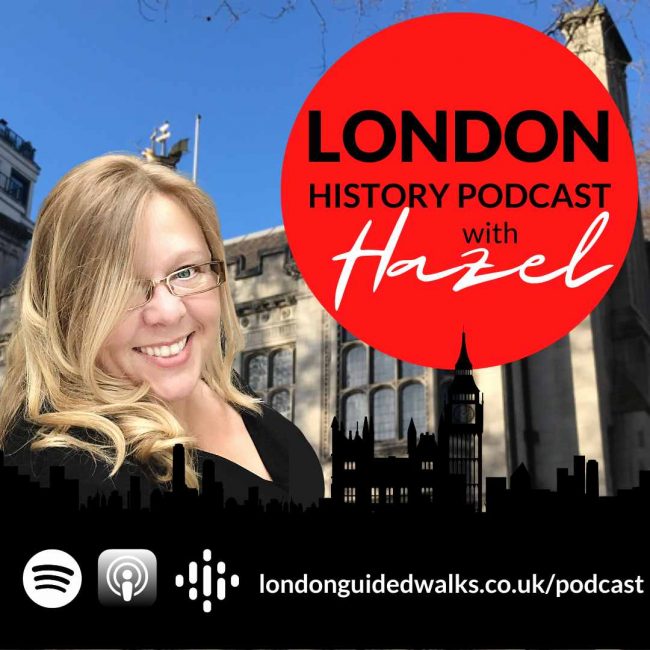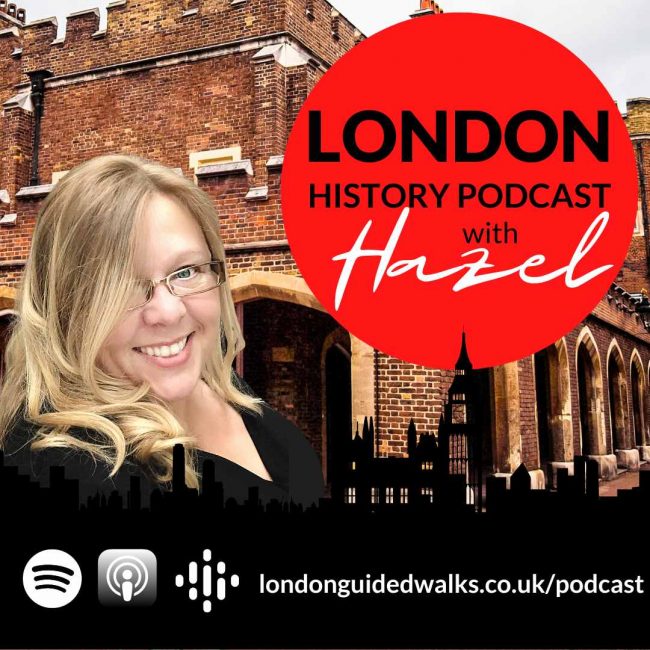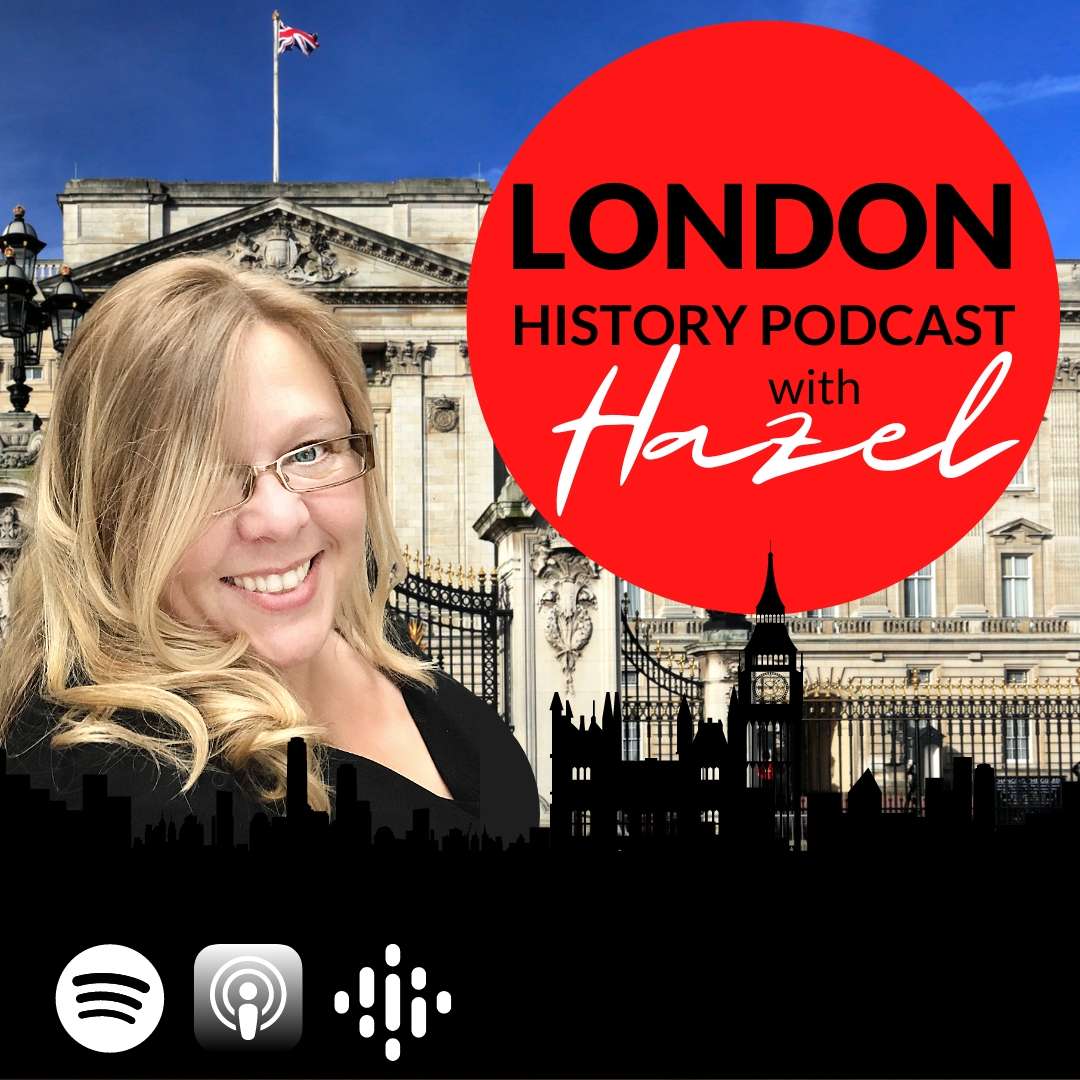
Related Walking Tours:
Medieval London Blog Posts:
Show Notes:
 Hazel Baker: Hello and welcome to London Guided Walks London History podcast. In the coming episodes, we will be sharing our love and passion for London, its people, places and history in an espresso shot with a splash of personality. For those of you who don’t know me, I am Hazel Baker, founder of London Guided Walks, providing guided walks and private tours to Londoners and visitors alike.
Hazel Baker: Hello and welcome to London Guided Walks London History podcast. In the coming episodes, we will be sharing our love and passion for London, its people, places and history in an espresso shot with a splash of personality. For those of you who don’t know me, I am Hazel Baker, founder of London Guided Walks, providing guided walks and private tours to Londoners and visitors alike.
Our blog is regularly updated with posts written by our passionate team of qualified London tour guides. And there are literally hundreds for you to choose from, all absolutely free.
And don’t forget also, we have show notes attached to every single episode with a transcript and any photos, maps, or videos that we may have as well.
Thank you so much for everybody supporting, we have now 25,000 downloads, which is amazing. So, thank you very much. And thank you to all of those who have written a review or at least ticked the stars. And if you haven’t, please, please do that. This is how we share our love of London with others. We’ve had some really nice comments from several teachers, actually.
Roman London: an Introduction, and also The Black Death, and also our Frost Fairs podcasts have been rather popular because of course, children are learning about this in schools. So, if you know a teacher who is stuck for inspiration on how to get the kids engaged, then maybe 20 minutes of a podcast can give them a little bit of help there.
Right, now on with the show. Joining me in the studio today is City of London tour guide, Ian McDiarmid.
 Ian McDiarmid: Hello there.
Ian McDiarmid: Hello there.
Hazel Baker: Alright, thanks for joining us today because we are going to be talking about Medieval London Friaries, aren’t we?
Ian McDiarmid: That’s right.
Hazel Baker: I think maybe the best question to start off with is well, what is a friary and who were the friars?
Ian McDiarmid: The friars begin at the beginning of the 13th century and the first two orders of the Dominican’s and the Franciscans. And these are founded by some Dominic and some Francis of Assisi. And the things that characterize the friars are a commitment to poverty, which monks in theory were signed up for, but they weren’t necessarily great at following. And perhaps the most important distinction is that they would go out and preach. And some Francis, when he starts, he goes around barefoot with four companions. And the idea is that. Teach the gospel of Christ through words, but also through his example, through his commitment to poverty.
Hazel Baker: So, when we think of Friar Tuck in Robinhood times, he’s a friar then?
Ian McDiarmid: Yes. But I wouldn’t like to say which order he belonged to, but yes, he’s a friar and you can, in a way you can tell he’s a friar cause he’s out and about, he’s not, this is one of the key distinctions is that monks live in monasteries and they don’t go outside the monastery and the monastery is kind of like a, a sort of powerhouse. Giving prayer the whole time. And one other important aspect of this is that their liturgy that is the liturgy of monks, takes pretty much all day. I mean, if you read about Medieval monks and follow what they’re actually doing, basically all day long, they’re praying. I mean they make modifications to that and yet there are friars who we’re talking about today. They go out into the community and they preach.
Like the monks they’re following a religious rule. Hence the word regular from the Latin Regulus rules covers both of them. But in the case of the friars the liturgy is very much reduced. So, they spend few hours each day in prayer and they’ve got more time to devote to…
Hazel Baker: outreach programs.
Ian McDiarmid: Yeah, it is as a kind of Medieval outreach program. And this is one reason why the church, the church in general is very suspicious of innovation, but they take these on and they take them on for two reasons.
For one, the church at this time was facing a little local difficulty in the South of France in the form of Catharism and the cathars were heretics. They believed in dualism. They believed that the physical world was created by the devil and the spiritual world was created by God. This was a very powerful, powerful religion. And it was led by men called parfait who were the equivalent to priests and they were very spiritual, very disciplined. And the preaching orders and in particular, Dominican’s were very useful in combating these heretics.
And the second reason because these friars were very well suited from the church’s point of view to reaching urban populations, which weren’t necessarily particularly well served by the parish clergy. Cities like London, you get the friaries and London has far more friaries than anywhere else in England.
Hazel Baker: How many friars were there in London?
Ian McDiarmid: Well, it’s a little bit complicated, five main ones. But a brief period for about 50 years, there was a very small order called the sack friars. And there was also an order called the pied fries that they were out towards Covent Garden. But they don’t last very long. But there are five big ones: Black friars – the Dominicans, the Franciscans – the Greyfriars, the White friars – Carmelites, the Crutch Friars, and the Austin Friars.
Hazel Baker: Well perhaps the best friars to start off with, are the most famous in London, which are the Black friars because there’s a train and tube station there.
Ian McDiarmid: And not only a train and tube to station Hazel, but also a pub.
Hazel Baker: Oh yes. The pub. How could I ever have forgot it?
Ian McDiarmid: So, if you imagine that you’ve gone out of Black friars station and I guess for people who don’t know London well Black friars bridge right by back bridge and opposite the Unilever building.
So, if you come out of a Black friars station and turn slightly to your right, so you’re facing directly North you find yourself from the rather unpleasant spot unpleasant because there’s all the rush of the commuters who have been using the mainline rail station and the underground stations behind you. But also, you’re on a major road junction. And in front of you running directly North is a big road, new bridge street. To your right sweeping down towards you from a sort of East North, easterly direction is Queen Victoria Street. Again, another major thoroughfare, and then behind you continuing new bridge street, going South over the river is Black friars road bridge.
And then finally, on the other side of the junction, there is a slip road for traffic coming towards you from the West to the East who are running along the embankment, which runs along the Thames and they can take the slip road to join this junk.
Hazel Baker: So that was very different though. And 1300s, wasn’t it?
Ian McDiarmid: Yeah, completely. And I think this is one of the attractions for me. And I think for you as well, particularly the city of London where, so little of the fabric remains, but trying to imaginatively reconstruct what it looked like. And these places were so important as well.
So, the first thing to say that if we go back to the 1300 where we’re standing, you wouldn’t be able to stand because you’d be in the Thames. So, we have to imagine ourselves on a boat because Queen Victoria Street marks the Northern bank of the Thames. And then if you remember, I was also talking about one other major thoroughfare, which is new bridge street, which runs from the North to the South. No Black friars bridge behind you back then. The only way to cross the river was at London bridge. So today, you’ve got this big road, new bridge street that wasn’t there. New bridge street is on the side of the fleet river, which runs rather diminished today underneath it. So, this site is very, very important, and you’re looking at a corner of where two major waterways meet. The fleet, which is the largest tributary of the teams within London and then the Thames itself.
Hazel Baker: So, if I was alignment wanting to get into the precinct of black friars, where would I go
Ian McDiarmid: Well, you’d have to wander all the way up to the North. So, I should say that from our little spot where these rivers meet, the other thing that you could see apart from the rivers meeting of this huge brick wall, which as you’ve mentioned they disparate war went around the precinct at the, the friar of the Dominican’s.
And to get into this as a layman, you’d have to, or laywoman, you’d have to go right up to what is Ludgate Hill. Walk along there. And if you’re walking towards Saint Paul’s Cathedral on your right would be a little lane that would take you down off Ludgate Hill and towards this precinct ward. And you’d be met by this huge gate.
Now, if you are really important, you could access the friary from another route. And that is where we were sitting in our little boat. There’d be a little gate down there. And that was probably the main gate for important visitors. And this friary was so important that when Henry the eighth entertains the Holy Roman Emperor, Charles V, Charles V actually stays in Black friars.
They have sittings of parliament in Black friars. And when Henry VIII has the court to examine the validity of his marriage to Catherine of Aragon i.e., he wants to start get rid of it. He has Cardinal Woolsey and Cardinal Campeggio. They have a little court to examine the legitimacy of the marriage and it takes place in Black friars. So, it’s enormously important.
And this precinct is huge. It’s eight acres. And to put that in some kind of context, an acre is, there are one and a half acres in a football pit. And this was the largest precinct in London after that of St. Paul’s Cathedral.
Hazel Baker: Wow. So, if I gone through the main gate in the North, what would I have seen?
Ian McDiarmid: Well, first of all, you have come across the graveyard and the graveyard wasn’t just for the monks. It was also for people, and this is a common feature of the friaries and indeed some other houses in London that you’d have a main road, a gate, a graveyard, and then to the South of the graveyard, you have the big church itself. And the church was substantial. This one was 245ft long, I think. And then as lay people, you wouldn’t really be able to get much beyond the church because the rest of the friary is sort of private ground for the friars. And immediately to the South of this big church with two very substantial cloisters. And also, very large gardens and within the Cloisters where the chapter house.
Now with regards to Black friars and indeed with regard to the other friaries, there is very, very little remaining today. So enormously important, huge, huge sites, huge importance politically, great impact on the landscape of London, but very, very little survives. And if you want to find anything, the only bit the Black friars that’s easily accessible is that if you go roughly into the middle of this precinct area you will find old St. Anne’s churchyard, which is in Ireland Yard. And there they’ve got a big piece of stone, a big piece of masonry, which belonged to the original chapter house. And the reason they don’t survive is because of the dissolution when the properties were sold off, the materials were robbed, and then The Great Fire of 1666 put pay to a lot of them.
Despite these two great crises, one bit of the London Friaries did survive. The Austin Friars, the nave of their friary survived as the so-called Dutch Church all the way up to the 20th century. But unfortunately, it was destroyed in a bombing raid in 1914 in the blitz.
Hazel Baker: So, these friaries really would have stood out, wouldn’t they?
Ian McDiarmid: Yes, they would have done. And they’re just part of the ecclesiastical landscape. So, we’ve got over a hundred parish churches. We’ve got the great cathedral of St. Paul’s. We’ve got the various monasteries and John Stow, the great chronicler of London who is writing at the end of the 16th century. He’s very useful as a source because although he’s a bit later than this period, he gives a kind of walking tour through the wards, the administrative districts of the cities, and he counts about 20 monastic houses within the precincts and sitting on the boundaries of the city. So, there’s a huge number and we’ve got to add our five friaries to this number. So, there’s a huge number of religious buildings. And not only is there a huge number there’s also these precincts, which would have stood out again, because they’d been very dominant, but also unusual because they’ve got big gardens in them. Those as we think indicators as a lay person, you wouldn’t necessarily have access to them.
But the other really key thing about these religious buildings is that they’re all built of stone. And the secular i.e., non-religious buildings apart from the Guildhall, which is the great administrative centre of London, largely built of timber. So, they really would have stood out to somebody walking through London at this time.
Hazel Baker: And something you’ve said, but maybe not stated is that the London, you know, we’re very able to walk up and down streets now and access London, but that wasn’t the case in Medieval society, was it? It had the religious precincts and also the guilds, all of these are walled and not areas that you can necessarily enter. So, you weren’t really free to wander around London. That is something of a very new concept.
Ian McDiarmid: Yeah, that’s absolutely right though. We need to qualify that in the case of the friars, because what we’ve said already is that one of the big distinctions is that they’re a little bit more open to lay society than the monasteries are. And they would actually welcome people into the first part of their precincts as part of their preaching remit.
And I was describing how big Black friars church was, the largest church in London after St. Paul’s was that of Greyfriars, which from memory was 299ft long. And the way this works is that when the friars initially get established, they build small chapels, but then in the third quarter of the 13th century, so the 12th centuries, 12 ages around that time, they generally massively enlarged their churches. And this is when the Greyfriars big churches built is when, when the Dominican’s built theirs. And the reason they want such big churches is partly to sort of show off and show their presence. But also, it’s practical because they presumably wanted to fill these naves with people listening to them preaching. And you also need to have a large choir as well because the choir is where the friars will be officiating. So, if you’ve got a large choir, you’re going to have an even bigger nave. So, these are very, very impressive churches.
Hazel Baker: So, you said about how these friars go out into the community. Other than preaching, what do they do?
Ian McDiarmid: Well, the main other thing that distinguishes the friars is the commitment to poverty. Now, monks, when they first get going as religious orders, they all have a commitment to poverty, but it gets left by the wayside to varying degrees and the friars really reinvigorate this. And they are known as the mendicant orders, mendicant means begging.
And in the early days, at the time of Dominic and St. Francis, they did beg. And interestingly, when they went begging, they weren’t allowed to beg for money. They could beg for food, they could beg for clothes, but not for money. And they maintain this commitment to poverty to varying degrees.
The audit that really does maintain it is the Franciscans and for the early part of the history, for example, the Franciscans are banned from handling money, which slightly complicates a lot of their business dealings. Now it’s difficult, really to establish to what extent they carried on begging. I don’t think they did very much, maybe the Franciscans a little bit, but what is certainly the case is that the receiving of alms remains a very important part. And it looks as though alms were perhaps the second most important source of money for second source of revenue for the friaries. And it may sound a bit odd to say that they weren’t out begging, but they were receiving alms, but alms cover the sort of high-end of charitable giving. So, if you were a wealthy person you might give the monks all foods say, and there’s an example of another friary, not in London, where the King, who’s obviously a very desirable alms giver, gives all the friars a pair of shoes each
Hazel Baker: Very nice. So, hearing all of this, then I think that Friar Tuck was very good in his endeavours.
Ian McDiarmid: Well because he had a nice tummy, you mean?
Hazel Baker: Yes.
Ian McDiarmid: And there’s also nice statues of Black friars outside the Black friars pub who are a little bit on the Portuguese side. And I think this popular image of the friars leads into an initiative question, which is how they were regarded by Londoners. And it’s very difficult to reconstruct. I mean, some writers writing about religion at this point, think of the Catholic church as being full of ridiculous ceremonies, which nobody took too seriously and resented the opulence of these, of religious people in general. And saying that they didn’t do very much work. They were very idle. On the other hand, there have been revisionist historians since the 1980s who are trying to emphasize the deep popularity of a Medieval Catholicism within England.
And turning to the friars, we don’t have much evidence, but what we can say is that people, Londoners, wealthy Londoners were leaving requests in their wills to friars and indeed asking to be buried within the friars right up to the dissolution of the friaries in 1538.
But on the other hand, we can also see that when the houses are dissolved there’s only a very few friars in them. There might be 15 or 20, whereas in their heyday, the Dominican’s for example, who were the largest, they had a hundred or so friars before The Black Death. And that might indicate some waning of the ideal idealism behind it.
And finally, one other indication of possible waning of the Friar’s mission was that when we come to the dissolution, only one of these London friaries, the White Friars, the Carmelites, present any kind of opposition to it. And this may well be self-interest. It may be the friars just sort of thinking, oh well we know what was coming. But it could also be that the friars themselves have been won over to some extent to the reformed ideals. And an interesting example of this is Austin Friars, where Thomas Cromwell, the architect of the English reformation, architected the dissolution, he goes to live in Austin Friars. He’s granted to the use of a very substantial tenement there. And that may well be an indication of the friar working in hand with Cromwell and sympathizing with what he’s trying to do.
Hazel Baker: And you’ve done two other Medieval themed podcasts, haven’t you? The Black Death and also Medieval Guilds.
Ian McDiarmid: Yes.
Hazel Baker: So, if you haven’t listened to those and you want to immerse yourself more into the Medieval world, then you can listen to both of those. Also, if people want to get out and about, then there’s several walks that they can do to join us on there. You do a very good Medieval London walk.
Ian McDiarmid: Yes. And very much looking forward to doing that again, when the lockdown restrictions end, we’re all going to be very keen to get going on.
Hazel Baker: Yes. Yeah, absolutely. And then I also deliver a Best of Black friars Walk. Yeah. So, it’s not all Medieval. We do a bit of Roman but we do basically walk the precinct of Black friars. We get to see that bit of masonry that you were talking about from the parish church. So, the theme is Black friars so we get to go travel through history and time on that one.
And that’s all for now. We’ll see you next week.

